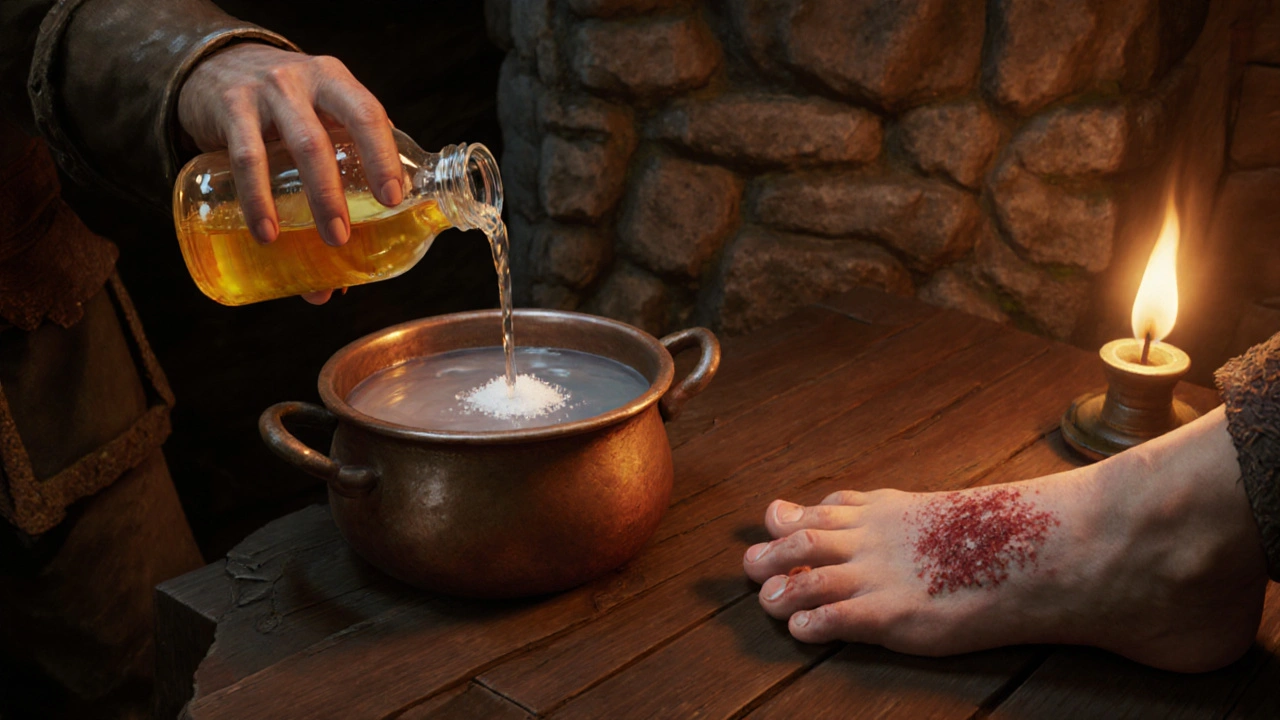Athlete's Foot Vinegar Solution Calculator
Calculate the correct apple cider vinegar solution for athlete's foot treatment based on your basin size and skin condition.
Your Solution
Treatment Instructions
- Soak for
- Frequency:
- Duration:
Important Safety Notes: Always test on a small area first. Avoid full-strength vinegar on open wounds. Ensure solution is lukewarm (not hot).
Got an itchy, cracking foot that just won’t quit? Chances are you’re dealing with athlete’s foot, a stubborn fungal infection that loves warm, damp environments. While pharmacy shelves are full of creams, many people swear by a kitchen staple: apple cider vinegar. Below you’ll learn exactly how to turn that bottle into a fast‑acting, low‑cost treatment and when you should call a professional.
What is Athlete’s Foot?
Athlete's foot is tinea pedis, a fungal infection that targets the skin on the feet, especially between the toes. The culprit is usually a dermatophyte called Trichophyton rubrum, which thrives in sweaty shoes, public showers, and locker rooms. Symptoms range from mild itching to painful cracking, blisters, and a characteristic white‑to‑red scaling.
Why Apple Cider Vinegar Can Help
Apple Cider Vinegar is a fermented liquid made from apples that contains acetic acid, malic acid, and a host of antimicrobial compounds. Its acidity (pH≈2.5‑3) creates an environment that many fungi find hostile, slowing growth and eventually killing the spores. Additionally, the vinegar’s natural enzymes can help exfoliate dead skin, allowing healthier skin to surface.
Preparing a Safe, Effective Solution
- Gather a clean basin large enough to fit both feet.
- Mix one part Apple Cider Vinegar with two parts warm (not hot) water. Warm water improves absorption but won’t burn delicate skin.
- Add a pinch of sea salt if you have extra irritation-salt helps draw out moisture from the infection site.
- Stir until the salt dissolves completely.
Test the temperature with your wrist; it should feel comfortably warm. A solution that’s too hot can worsen skin damage, while lukewarm water keeps the pores open for better absorption.

Three Simple Treatment Methods
- Foot Soak: Submerge both feet for 15‑20 minutes once daily. Gently rub the affected areas with a soft brush or washcloth after soaking to remove dead skin.
- Compress: Soak a clean cloth in the same solution, wring out excess liquid, and place it on the infected toe spaces for 10 minutes. This method is handy when you can’t sit in a basin.
- Spray: Transfer the mixture into a spray bottle. After each shower, spray the solution onto the feet and let it air‑dry. This reinforces the acidic barrier throughout the day.
Consistency is key. Most people notice reduced itching after three to five days, but continue the regimen for at least two weeks to ensure the fungus is fully eradicated.
Supportive Practices for Faster Healing
Even the best home remedy can be undermined by poor foot hygiene. Pair the vinegar treatment with these habits:
- Dry Thoroughly: After any moisture exposure, pat the spaces between the toes dry with a separate towel. Moisture is the fungus’s lifeblood.
- Change Socks: Wear breathable cotton or wool socks and switch them at least once a day.
- Choose Breathable Shoes: Rotate shoes daily, and sprinkle foot‑friendly powders (like Tea Tree Oil) inside to maintain a dry interior.
- Moisturize After Healing: Once the infection clears, apply a light, non‑occlusive foot balm to prevent cracking, which can invite reinfection.
How Apple Cider Vinegar Stacks Up Against Other Home Remedies
| Remedy | Key Active Component | Typical pH | Pros | Cons |
|---|---|---|---|---|
| Apple Cider Vinegar | Acetic & malic acids | 2.5‑3 | Readily available, inexpensive, dual‑action (antifungal + exfoliating) | Strong smell, may cause mild sting on raw skin |
| Tea Tree Oil | Terpinen‑4‑ol | ~5 (neutral when diluted) | Powerful antifungal, pleasant scent when mixed | Requires dilution; can be irritating for sensitive skin |
| Over‑the‑Counter Antifungal Cream | Clotrimazole or terbinafine | ~7 (neutral) | Clinically proven, fast‑acting | Higher cost, may cause allergic reactions |
All three options can work, but the vinegar soak wins on cost and the added benefit of softening dead skin. If you have very sensitive skin, start with a diluted tea‑tree spray before moving to a full‑strength soak.

Common Pitfalls & When to Seek Professional Help
- Skipping Drying: Even a short residue of moisture can reignite the fungus.
- Using Undiluted Vinegar: Pure acetic acid can burn cracked skin, worsening the condition.
- Stopping Early: Symptoms may fade quickly, but the fungus can linger underground. Finish the full two‑week course.
- Signs of Severe Infection: Red streaks up the leg, pus‑filled blisters, or fever indicate a secondary bacterial infection-see a GP promptly.
People with diabetes, peripheral neuropathy, or compromised immunity should consult a doctor before relying on home remedies, as slower healing can lead to complications.
Quick Takeaways
- Mix 1part apple cider vinegar with 2parts warm water; add a pinch of sea salt for extra comfort.
- Soak feet 15‑20minutes daily, or use a vinegar compress/spray.
- Dry feet thoroughly after each treatment; change socks regularly.
- Continue the regimen for at least 14days, even if itching stops.
- Switch to a light foot balm after healing to keep skin supple.
Frequently Asked Questions
Can I use apple cider vinegar if I have a cut on my foot?
Avoid full‑strength vinegar on open wounds. Dilute the solution further (1part vinegar to 3parts water) and test on a small area first. If stinging occurs, stop and see a healthcare professional.
How often should I repeat the soak?
Once daily is enough for most cases. If the infection is severe, a twice‑daily soak (morning and evening) can speed recovery, but always let the feet air‑dry between sessions.
Is there a risk of the fungus becoming resistant to vinegar?
Resistance is rare because vinegar works by altering the skin’s pH rather than targeting fungal enzymes directly. However, inconsistent use can let the fungus rebound.
Can I combine apple cider vinegar with other home remedies?
Yes. A common combo is a vinegar soak followed by a tea‑tree oil spray (diluted 5drops per ounce of water). The two act synergistically without harming each other.
When should I stop the treatment?
Finish at least a full 14‑day course, even if symptoms disappear. This ensures any hidden spores are cleared. If the rash returns after stopping, repeat the regimen for another week.

Matthew Platts
July 17, 2025 AT 18:07Give it a try, you’ll be surprised!
Kasey Mynatt
July 23, 2025 AT 21:21Hey folks, just a quick heads‑up: when you’re mixing apple cider vinegar for athlete’s foot, always start with a diluted solution. Use about one part vinegar to four parts lukewarm water, especially if you have any open cuts. Test the mixture on a small patch of skin first – you don’t want an unwanted burn. Remember to keep the soak time short, around 10‑15 minutes, and dry your feet thoroughly afterward. Consistency is key, so aim for daily soaks for about a week, then taper off as you see improvement.
Edwin Pennock
July 30, 2025 AT 00:34Honestly, vinegar is just a cheap myth. It won’t get rid of the fungus; you’ll just end up with stinky feet. If you really want to cure athlete’s foot, grab an antifungal cream from the pharmacy. The acid in vinegar can even irritate your skin further, especially if you have any tiny cracks.
John McGuire
August 5, 2025 AT 03:47😊 Totally get the enthusiasm, Matthew! A gentle soak can actually help balance the foot’s pH and keep the environment hostile to fungus. Just remember to keep the solution lukewarm-not hot-so you don’t damage the skin. Your feet will thank you! 👍
newsscribbles kunle
August 11, 2025 AT 07:01While I appreciate grassroots remedies, relying on kitchen staples over proven medicine can be a slippery slope. In many cultures, such shortcuts have led to prolonged suffering and unnecessary complications. Let’s not romanticise unverified cures when professional treatments exist.
Bernard Williams
August 17, 2025 AT 10:14Alright, let’s break down the whole Apple Cider Vinegar (ACV) foot soak step‑by‑step, so you have a clear roadmap.
First, gather your supplies: a basin large enough for both feet, ACV, warm water, a measuring cup, and, if you like, a pinch of sea salt for extra antiseptic power.
Second, decide on the dilution. For normal skin, mix one part ACV with four parts water. If you have sensitive skin or minor cuts, go even lighter-one part ACV to six parts water.
Third, warm the water to a comfortably tepid temperature (about 35‑38 °C). Hot water can exacerbate inflammation, while cold water won’t help the vinegar penetrate.
Fourth, combine the ACV and water in the basin, stirring gently to ensure an even solution. If you added sea salt, sprinkle it in now and let it dissolve.
Fifth, before you submerge, do a quick patch test: dip a toe‑nail into the solution for 10‑15 seconds, then rinse and check for any burning sensation. If it feels fine, you’re good to go.
Sixth, soak both feet for 10‑15 minutes. You can use a timer to stay consistent.
Seventh, after soaking, pat your feet dry with a clean towel, paying special attention to the spaces between your toes. Moisture is the enemy of fungus.
Eighth, apply an over‑the‑counter antifungal cream or powder if you have severe symptoms; the ACV soak works best as an adjunct, not a sole treatment.
Ninth, repeat this routine once daily for 7‑10 days. Most people notice a reduction in itching and scaling within the first week.
Tenth, monitor your progress. If the condition worsens or doesn’t improve after two weeks, seek professional medical advice.
Eleventh, remember to keep your footwear clean and dry. Rotate shoes, wear breathable socks, and consider using antifungal spray inside shoes.
Finally, stay consistent and patient. Natural remedies often require a bit more time than prescription meds, but they can be effective when used correctly.
Bernard Williams
August 23, 2025 AT 13:27Edwin, I see you’re skeptical, but the science does show that the acidic environment created by ACV can inhibit fungal growth. It’s not a miracle cure, but as a complementary measure it’s worth a try, especially for mild cases.
Michelle Morrison
August 29, 2025 AT 16:41One must consider the hidden agendas behind promoting over‑the‑counter solutions. The pharmaceutical lobby thrives on our dependence. Natural remedies, when properly vetted, serve as a silent rebellion against corporate control.
harold dixon
September 4, 2025 AT 19:54Curious about the exact ratio for a 500 ml basin-does a 1:4 mix translate to 100 ml of ACV and 400 ml of water? Also, would the addition of a pinch of sea salt significantly alter the pH, or is it mainly for its antibacterial properties?
Darrin Taylor
September 10, 2025 AT 23:07People love to hype up vinegar like it’s a panacea, but think about the chemicals that get into our bodies through these home concoctions. Is it really safer than an FDA‑approved topical?
Anthony MEMENTO
September 17, 2025 AT 02:21Vinegar works if you do it right the dosage matters not too much but consistent use is key
aishwarya venu
September 23, 2025 AT 05:34Great guide! Just wondering-if someone has very dry skin, should they add a bit of coconut oil after the soak?
Nicole Koshen
September 29, 2025 AT 08:47The instructions are clear, but watch out for comma splices-"mix one part ACV with four parts water, then test the solution" could be split into two sentences for better flow.
Ed Norton
October 5, 2025 AT 12:01Sounds solid, good luck!
Karen Misakyan
October 11, 2025 AT 15:14From a philosophical standpoint, the very act of seeking a remedy reflects an inherent human desire to restore equilibrium to the body’s micro‑ecosystem, a pursuit as ancient as Hippocratic medicine.
Amy Robbins
October 17, 2025 AT 18:27Oh, sure, because a bottle of cheap vinegar is suddenly the pinnacle of medical science. If you’re into herbal folklore, go ahead, but don’t blame me when the fungus wins.